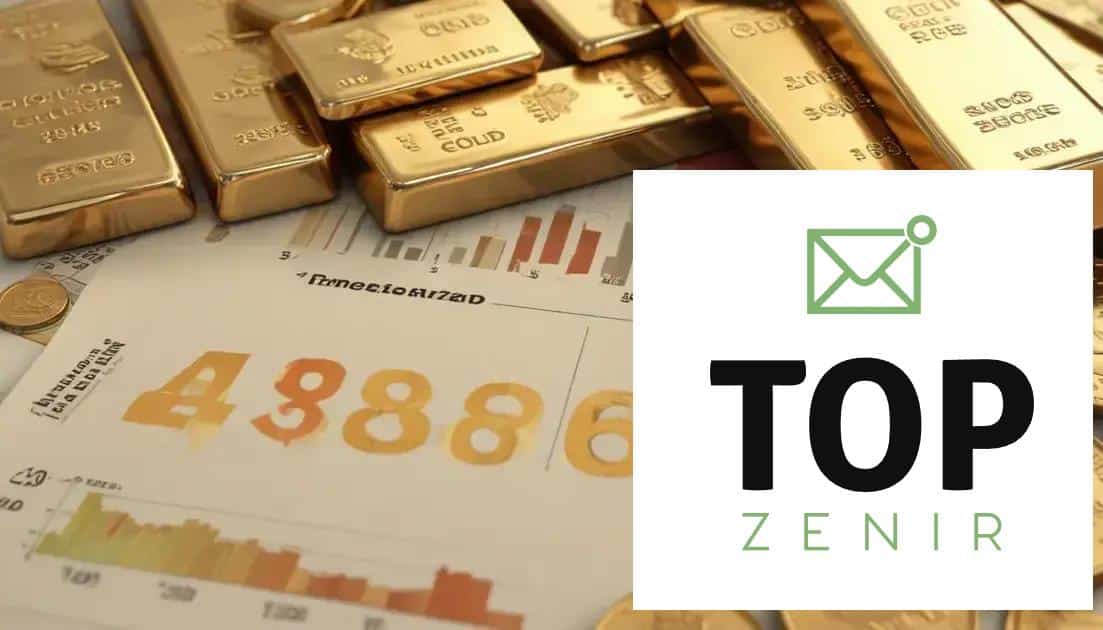Gold’s strength during financial instability: Why it matters

Gold’s strength during financial instability lies in its ability to retain value, making it a preferred safe haven for investors amid economic uncertainty and inflationary pressures.
Gold’s strength during financial instability is no coincidence. Many investors turn to gold when economic times get tough. But have you ever wondered why? Let’s find out.
Understanding gold’s historical significance
Understanding gold’s historical significance is crucial for grasping its enduring value. For centuries, gold has been more than just a metal; it has symbolized wealth and status. Ancient civilizations, like the Egyptians and the Romans, prized gold for its rarity and beauty.
The Role of Gold in Ancient Civilizations
Gold served many purposes in early societies. It was used for currency, ornaments, and religious artifacts. The Egyptians even buried their pharaohs with gold to ensure a safe passage to the afterlife. This practice reflects the deep cultural ties to gold as a representation of power.
Gold as a Economic Standard
Throughout history, gold has played a vital role in shaping economies. After the Gold Rushes in the 19th century, many nations transitioned to a gold standard. This system linked currency value directly to gold, ensuring stability and trust in monetary systems.
- The gold standard increased trade confidence.
- It limited inflation rates significantly.
- Many central banks held gold as a reserve.
Even as nations moved away from the gold standard, the precious metal continued to hold a significant place in the financial world. Today, its role has evolved but remains pertinent.
Gold in Modern Investing
In recent times, gold has become a safe haven during financial instability. Investors often flock to gold when other assets falter. This behavior stems from its historical significance as a reliable store of value in uncertain times.
Many modern portfolios include gold as a form of diversification. Its unique ability to retain value amid economic upheaval makes it a prudent investment choice. Historically, gold has not only withstood inflation but has also excelled when other investments declined.
Why investors flock to gold during crises

Many people wonder why investors flock to gold during crises. This precious metal often shines the brightest when financial markets face turmoil. The reason for this trend lies in gold’s historical role as a safe haven asset and its unique characteristics that appeal to investors in uncertain times.
Gold’s Intrinsic Value
Gold has an intrinsic value that is recognized worldwide. Unlike paper currency, its worth is not influenced by government policies or inflation. This makes it a reliable source of wealth preservation. During economic downturns, investors turn to gold because they know it holds its value, safeguarding their investments.
Market Volatility and Fear
During times of market volatility, fear often takes hold. Investors tend to panic, selling off assets that may lead to losses. In contrast, gold typically rises in value as people seek stability. The perception of gold as a secure investment helps drive demand upwards, further reinforcing its status during crises.
- Gold often acts inversely to stock market trends.
- Investors view it as a hedge against economic downturns.
- The metal is easily tradable in global markets.
Moreover, during crises, geopolitical tensions can rise. Investors may fear uncertainty not just in financial systems but also in global peace. As a result, gold becomes a go-to asset. The combination of its historical significance and intrinsic stability makes it appealing to those looking to protect their wealth.
Many financial experts often recommend including gold in a diversified portfolio. This inclusion can help mitigate losses when the economy falters. Investing in gold allows individuals to have a safeguard against various risks, enabling them to weather financial storms better.
The role of gold in diversifying portfolios
The role of gold in diversifying portfolios is vital for investors seeking balance and stability. Gold acts differently compared to stocks and bonds, making it an ideal choice for diversification. Adding gold to an investment mix can help reduce risk, especially during economic downturns.
Why Diversification Matters
Diversification is a strategy that spreads investments across various assets to minimize potential losses. When one asset class struggles, others may perform better. Gold provides a buffer against market volatility, often appreciating when other investments decline.
Gold’s Historical Performance
Historically, gold has shown resilience during economic downturns. For instance, during the 2008 financial crisis, gold prices surged as investors sought safe havens. This characteristic highlights its importance in a well-rounded portfolio.
- Gold typically retains its value during inflation.
- Its returns can offset losses from stocks.
- Gold can provide liquidity in times of financial stress.
Incorporating gold into a portfolio is relatively straightforward. Investors can choose from various avenues, including physical gold, ETFs, or stocks in mining companies. Each option may offer different benefits and levels of risk. Ultimately, the goal is to enhance overall portfolio performance.
Many financial advisors suggest allocating a percentage of your portfolio to gold, generally ranging from 5% to 10%. This allocation can help achieve a balance between risk and reward, especially in uncertain times. With gold as part of your strategy, you position yourself better against economic shifts.
How economic indicators affect gold prices

Understanding how economic indicators affect gold prices is essential for investors. Economic indicators give insights into a country’s financial health and can directly influence the value of gold. When the economy is strong, gold prices may stabilize or decline, but during times of uncertainty, they often rise.
Inflation and Gold Prices
Inflation is a key economic indicator impacting gold prices. When inflation rises, the purchasing power of currency falls. As a result, investors often turn to gold as a hedge against inflation. Typically, gold retains its value even when currency values decline, making it a sought-after asset during inflationary periods.
Interest Rates and Market Influence
Interest rates also play a crucial role. When interest rates are low, the opportunity cost of holding gold decreases. Investors are more likely to buy gold instead of keeping money in savings accounts that yield little return. Conversely, higher interest rates tend to make gold less attractive.
- Low interest rates often lead to increased demand for gold.
- High interest rates can decrease gold investment appeal.
- Market sentiment around interest rates can fluctuate quickly.
Another significant indicator is economic growth. When economies expand, people feel more confident and may invest in stocks instead of gold. However, in economic downturns, gold often shines as a safe haven. Similarly, geopolitical events can create instability, causing investors to flock to gold.
In addition, currency strength influences gold prices. A weak dollar typically makes gold cheaper for foreign buyers, increasing demand. Thus, the relationship between the dollar and gold is interconnected, and shifts can lead to price fluctuations.
Future outlook for gold amid financial uncertainty
The future outlook for gold amid financial uncertainty appears positive. As global markets remain volatile, many investors consider gold a vital asset for wealth preservation. The demand for gold tends to increase during uncertain times, making it a reliable investment for individuals looking to safeguard their assets.
Increasing Demand in Uncertain Markets
As economic conditions fluctuate, investors often gravitate toward gold. This trend is evident during times of economic downturn or geopolitical tensions. Whenever there is uncertainty, the allure of gold as a safe haven becomes stronger.
Gold’s Response to Inflation
Inflation poses a significant threat to purchasing power, and gold often performs well in such conditions. When inflation rises, the value of currency declines, leading investors to turn to gold. This reaction helps maintain gold’s appeal as a protective investment.
- Gold is seen as a hedge against inflation.
- Investors typically increase gold holdings during inflationary periods.
- The metal is considered a stable asset when currency values drop.
Looking ahead, financial analysts predict that demand for gold will continue to grow. Factors like economic instability and uncertainties regarding governmental policies can contribute to rising gold prices. Additionally, central banks across the globe are likely to increase their gold reserves to bolster national financial security.
Furthermore, technological advancements in gold extraction and processing can influence supply dynamics. As resources become more accessible, the cost of gold could potentially stabilize, although demand-driven price movements will remain a critical factor.
FAQ – Frequently Asked Questions about Gold Investment
What makes gold a safe haven during financial uncertainty?
Gold is considered a safe haven because it tends to retain its value when other investments decline, providing stability during economic turmoil.
How does inflation affect gold prices?
When inflation rises, the value of currency declines, prompting investors to seek gold as a hedge against inflation, which can drive up its price.
Why is diversification important in investment strategies?
Diversification reduces risk by spreading investments across different asset classes, and gold can enhance this strategy by providing stability during market fluctuations.
What factors are likely to increase the demand for gold in the future?
Demand for gold may rise due to ongoing economic uncertainties, inflation concerns, and geopolitical tensions, as investors look for reliable assets to protect their wealth.





